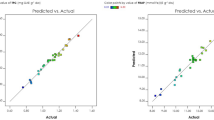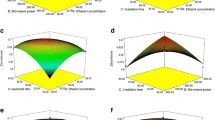Abstract
The use of a microwave-assisted extraction (MAE) method for the extraction of phlorotannins from Saccharina japonica Aresch (S. japonica) has been evaluated with particular emphasis on the influential parameters, including the ethanol concentration, solid/liquid ratio, extraction time, extraction temperature, and microwave power. The MAE procedure was optimized using single-factor design and orthogonal array design (OAD). The content of total phlorotannins in S. japonica was determined using a Folin-Ciocalteu (FC) assay. A maximum total phlorotannin content of 0.644 mg of phloroglucinol equivalent per gram of dry weight plant (mg PGE/g DW) was obtained using the optimized model, which included an ethanol concentration of 55%, solid/liquid ratio of 1:8, extraction time of 25 min, irradiation power of 400 W, and temperature of 60°C. Under similar conditions, the application of a conventional extraction method led to a lower phlorotannin yield of 0.585 mg PGE/g WD. These results demonstrated that the MAE approach provided better results for the extraction of phlorotannins from S. japonica and was a promising technique for the extraction of phenolic compounds from S. japonica and other materials. In addition, screening tests for the inhibitory activity showed that the phlorotannin-containing extracts significantly inhibited the growth of human hepatocellular carcinoma cells (HepG2) by inducing their apoptosis. The morphological changes that occurred during cell apoptosis were characterized using Hoechst33258 staining.
Similar content being viewed by others
References
Camel V. 2000. Microwave-assisted solvent extraction of environmental samples. TrAC-Trend Anal Chem, 19: 229–248.
Chen Y Z, Zhao L, Liu B G, Zuo S S. 2012. Application of response surface methodology to optimize microwave-assisted extraction of polysaccharide from Tremella. Physics Procedia, 24: 429–433.
Chu Y K, Lu J G, Yin J K, Cai L, Liu Y. 2009. Inhibitory effect of mycophenolate mofetil on human hepatocellular carcinoma cell line HepG-2. Journal of Medical Colleges of PLA, 24: 208–214.
Gribova N Y, Filippenko T A, Nikolaevskii A N, Belaya N I, Tsybulenko A A. 2008. Optimization of conditions for the extraction of antioxidants from solid parts of medicinal plants. J. Anal. Chem., 63(11): 1 034–1 037.
Guo L, Cho S Y, Kang S S, Lee S H, Baek, H Y, Kim Y S. 2007. Orthogonal array design for optimizing extraction efficiency of active constituents from Jakyak-Gamcho decoction, the complex formula of herbal medicines, paeoniae radix and glycyrrhizae radix. J. Ethnopharmacol., 113(2): 306–311.
Herodez S S, Hadolin M, Skerget M, Knez Z. 2003. Solvent extraction study of antioxidants from Balm (Melissa officinalis L.) leaves. Food Chem., 80(2): 275–282.
Huang L, Wen K, Gao X, Liu Y. 2010. Hypolipidemic effect of fucoidan from Laminaria japonica in hyperlipidemic rats. Pharm. Biol., 48(4): 422–426.
Huie C W. 2002. A review of modern sample preparation techniques for the extraction and analysis of medicinal plants. Anal. Bioanal. Chem., 373: 23–30.
Jeong J B, Hong S C, Jeong H J. 2009. 3,4-Dihydroxybenzaldehyde purified from the barley seeds (Hordeum vulgare) inhibits oxidative DNA damage and apoptosis via its antioxidant activity. Phytomedicine, 16(1): 85–94.
Karpakavalli K, Sini K R, Arthi I. 2012. Microwave assisted extraction and estimation of piperine, andrographolide using HPLC techniques. Pharmacie Globale (IJCP), 5(3): 1–5.
Lao M J, Wang Y G. 2010. Study on the extracting technology of kelp poly-phenols. Food Research and Development, 31(9): 93–96. (in Chinese with English abstract)
Lee S M, Lee J H. 2011. The isolation and characterization of simultaneous saccharification and fermentation microorganisms for Laminaria japonica utilization. Bioresource Technol., 102: 5 962–5 967.
Liu X, Wu K G, Chai X H, Yu H P. 2010. Purification of polyphenols from Laminaria Japonica and its antioxidant capacity. Sci. Technol. Food Ind., 31(5): 160–163. (in Chinese with English abstract)
Mcdonald S, Prenzler P D, Autolovich M, Robards K. 2001. Phenolic content and antioxidant activity of olive extracts. Food Chem., 73: 73–84.
Moreira M M, Morais S, Barros A A, Cristina D M, Guido L F. 2012. A novel application of microwave-assisted extraction of polyphenols from brewer’s spent grain with HPLC-DAD-MS analysis. Anal. Bioanal. Chem., 403: 1 019–1 029.
Naghibi B, Ghafghazi T, Hajhashemi V, Talebi A, Taheri D. 2007. The effect of 2,3-dihydroxybenzoic acid and tempol in prevention of vancomycin-induced nephrotoxicity in rats. Toxicology, 232(3): 192–199.
Pan X J, Liu H Z, Jia G H, Shu Y Y. 2000. Microwaveassisted extraction of glycyrrhizic acid from licorice root. Biochem. Eng. J., 5: 173–177.
Ragan M A, Glombitza K W. 1986. Phlorotannins, brown algal polyphenols. In: Hellebustand J A, Craigie J S eds. Handbook of Phycological Methods, Vol. II. Cambridge University Press, Cambridge. p.129–241.
Simsek M, Sumnu G, Sahin S. 2012. Microwave assisted extraction of phenolic compounds from sour cherry pomace. Separ. Sci. Technol., 47: 1 248–1 254.
Skehan P, Storeng R, Scudiero D, Monk A, Mcmahon J, Visica D. 1990. New colorimetric cytotoxicity assay for anticancer-drug screening. J. Natl. Cancer Ins., 82(13): 1 107–1 112.
Son Y K, Jin S E, Kim H R, Woo H C, Jung H A, Choi J S. 2011. Inhibitory activities of the edible brown alga Laminaria japonica on glucose-mediated protein damage and rat lens aldose reductase. Fish Sci., 77: 1 069–1 079.
Steinberg P D. 1992. Geographical variation in the interaction between marine herbivores and brown algal secondary metabolites. In: Paul V J ed. Ecological Roles of Marine Natural Products. Cornell University Press, New York, USA. p.51–92.
Wang L, Zeng M Y, Dong S Y, Liu Z Y, Yang H C. 2009. Study on the preparation of kelp polyphenols and the effect of kelp polyphenols on the fresh-keeping of Peneaus vannmei. Sci. Technol. Food Ind., 30(10): 187–191. (in Chinese with English abstract)
Wettasinghe M, Shahidi F. 1999. Evening primrose meal: a source of natural antioxidants and scavenger of hydrogen peroxide and oxygen-derived free radicals. J. Agric. Food Chem., 47(5): 399–414.
Wu T, Yan J, Liu R H, Marcone M F, Aisa H A, Tsao R. 2012. Optimization of microwave-assisted extraction of phenolics from potato and its downstream waste using orthogonal array design. Food Chem., 133: 1 292–1 298.
Yan M M, Liu W, Fu Y J, Zu Y G, Chen C Y, Luo M. 2010. Optimisation of the microwave-assisted extraction process for four main astragalosides in Radix Astragali. Food Chem., 119: 1 663–1 670.
Yang H C, Zeng M Y, Dong S Y, Liu Z Y, Li R X. 2010. Antiproliferative activity of phlorotannin extracts from brown algae Laminaria japonica Aresch. Chin. J. Oceanol. Limnol., 28(1): 122–130.
Zhang Z F, Lü G Y, Pan H J, Fa L F. 2012. Optimisation of the microwave-assisted extraction process for six phenolic compounds in Agaricus blazei murrill. Int. J. Food Sci. Tech., 47: 24–31.
Zou T B, Wang D L, Guo H H, Zhu Y N, Luo X Q, Liu F Q, Ling W H. 2012. Optimization of microwave-assisted extraction of anthocyanins from mulberry and identification of anthocyanins in extract using HPLC-ESIMS. J. Food Sci., 71(1): C46–50.
Author information
Authors and Affiliations
Corresponding authors
Additional information
Supported by the National Natural Science Foundation of China (No. 51203028), Rural Science and Technology Correspondent and Technology Service System Construction Projects, Guangdong Province (No. 2010A020507001-91), and Science and Technology Project of Panyu District, Guangzhou City (No. 2010-12-08)
Rights and permissions
About this article
Cite this article
He, Z., Chen, Y., Chen, Y. et al. Optimization of the microwave-assisted extraction of phlorotannins from Saccharina japonica Aresch and evaluation of the inhibitory effects of phlorotannin-containing extracts on HepG2 cancer cells. Chin. J. Ocean. Limnol. 31, 1045–1054 (2013). https://doi.org/10.1007/s00343-013-2321-x
Received:
Accepted:
Published:
Issue Date:
DOI: https://doi.org/10.1007/s00343-013-2321-x




